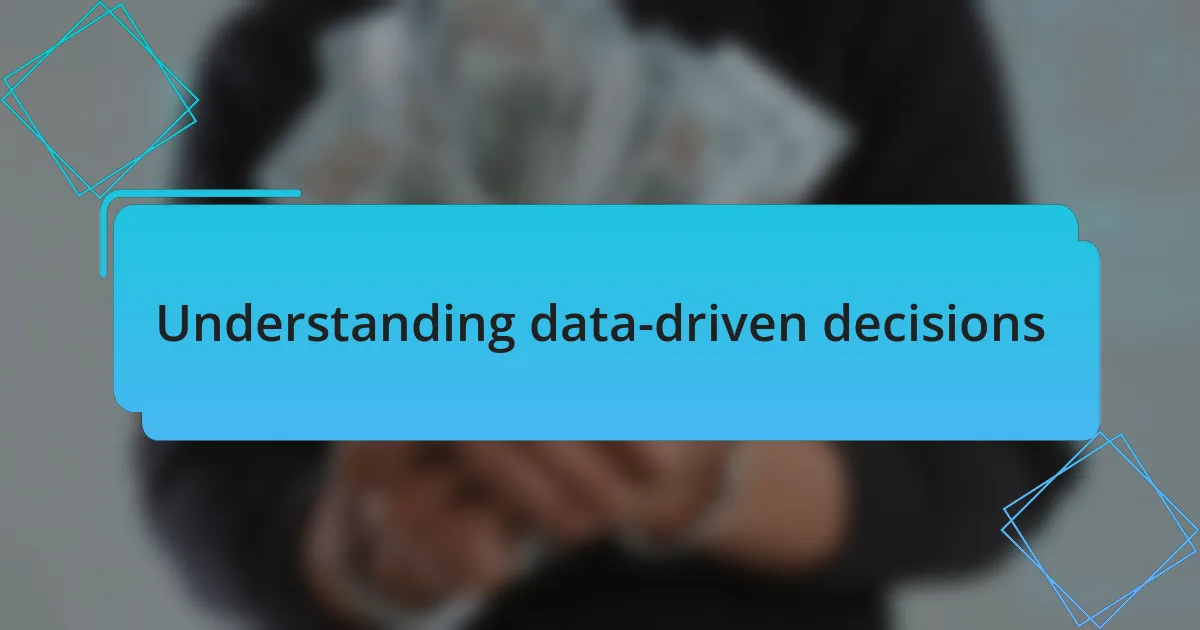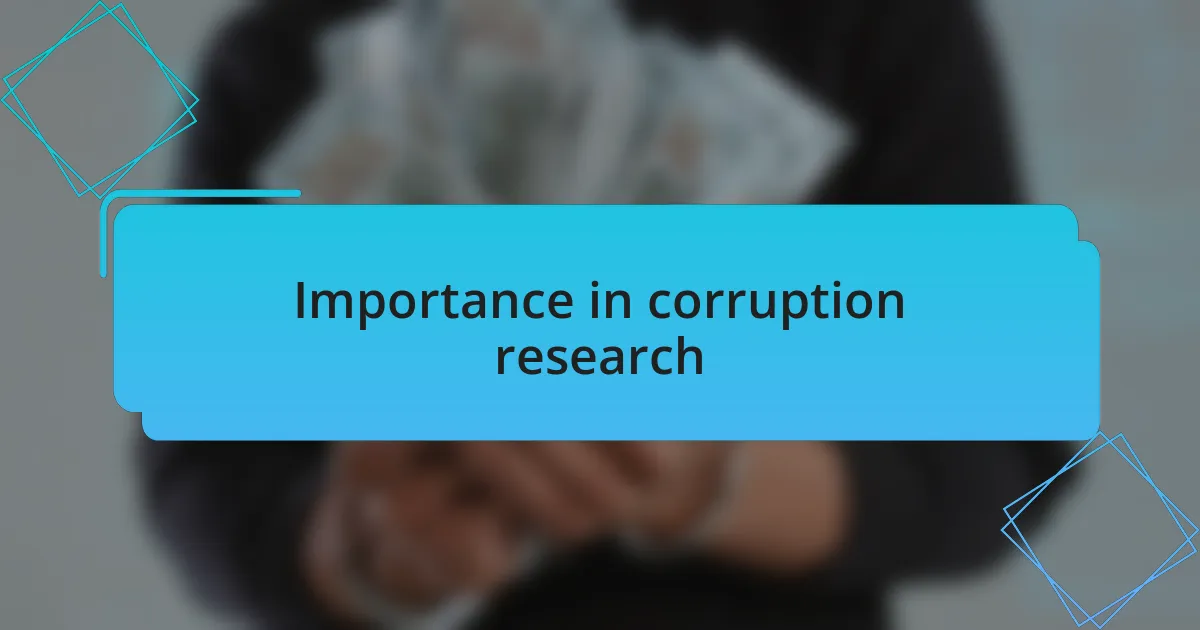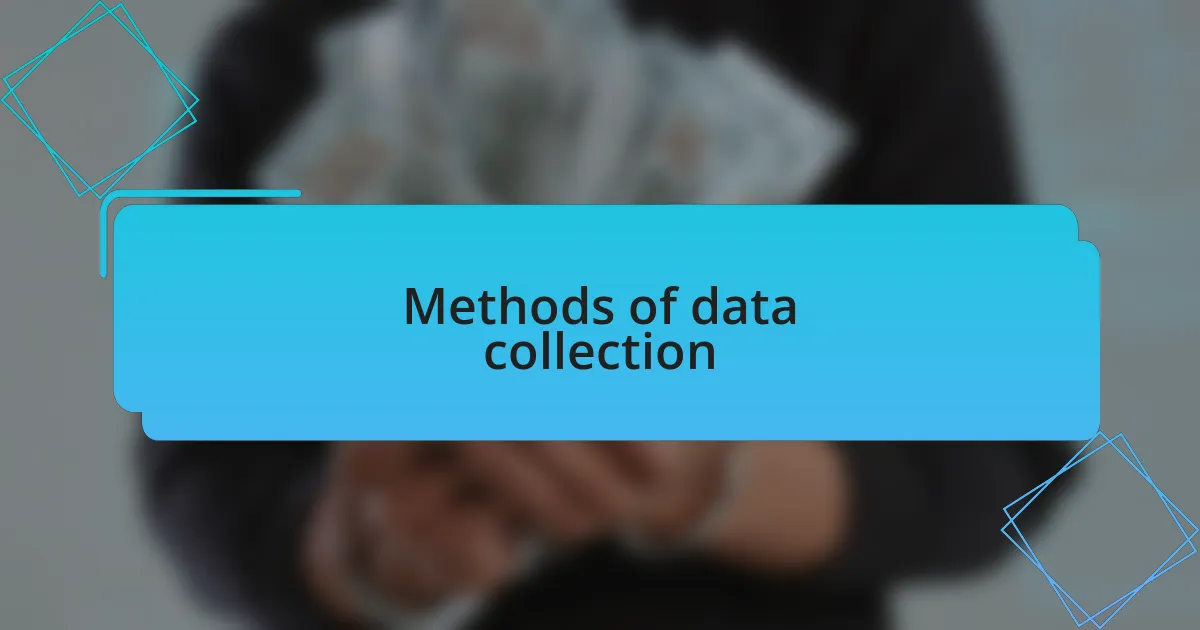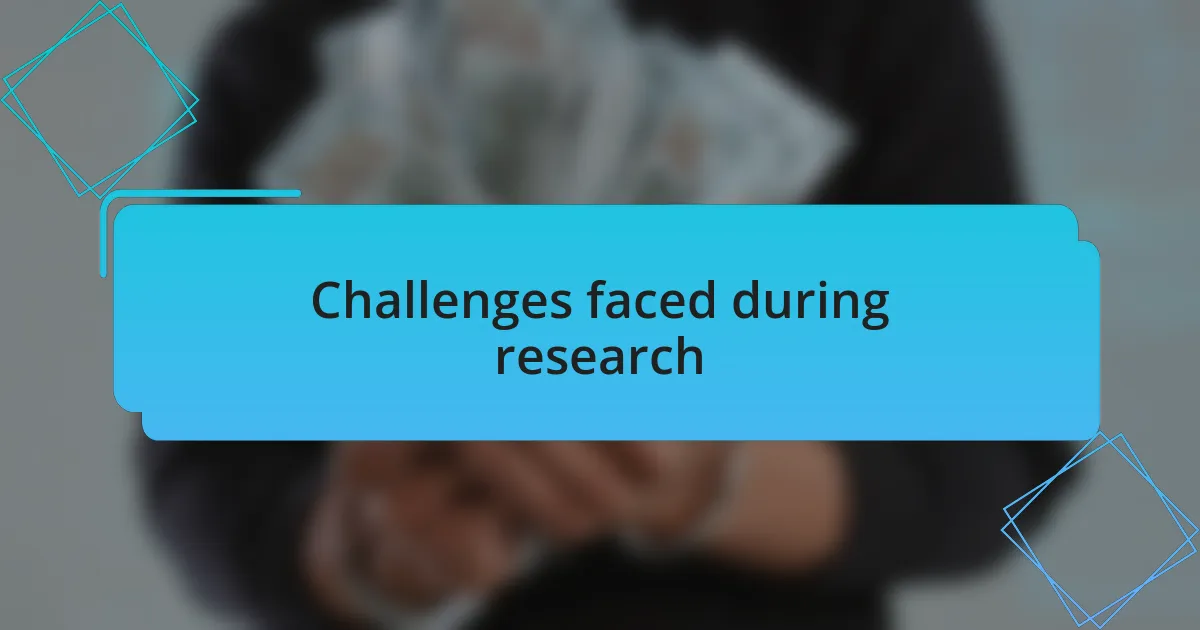Key takeaways:
- Data-driven decisions reveal hidden patterns in corruption, enabling deeper insights and effective policy-making.
- Combining qualitative methods (like interviews) with quantitative data enhances understanding and storytelling in corruption research.
- Challenges such as data inaccuracies and access to information can hinder research, necessitating a balance between emotional engagement and objective analysis.
- Research findings can influence policy changes and foster community empowerment, demonstrating the practical applications of data in combating corruption.

Understanding data-driven decisions
Data-driven decisions hinge on the idea that insights gleaned from data can illuminate the path forward, especially in complex areas like corruption research. I remember diving into a set of statistics that highlighted irregular patterns in government spending. It was eye-opening to see how raw numbers can unveil discrepancies that may be overlooked in qualitative analyses.
One pivotal moment for me was when I compared different data sets on public procurement. The stark contrasts painted a clearer picture of where corruption might thrive. Have you ever felt that rush of discovery when numbers tell a story? That’s the beauty of data-driven decisions; they enable us to connect dots we didn’t even realize were there.
Embracing data isn’t just about collecting numbers; it’s about interpreting them with an analytical mindset. I often find myself reflecting on how many insights are buried in plain sight. By focusing on the data, we empower ourselves to make informed choices that can lead to real change. How do we align our values with the numbers we analyze? This quest for alignment is essential in our journey toward understanding corruption more deeply.

Importance in corruption research
Understanding the importance of data-driven decisions in corruption research is crucial for revealing systemic issues. I recall a project where analyzing reports on land grants uncovered staggering trends of favoritism. It shocked me to realize that numerical analysis can expose hidden injustices that narratives might subtly disguise, making me wonder how many stories of inequity remain untold.
Diving deep into datasets not only improves transparency but also fosters accountability among those in power. In one instance, I analyzed financial disclosures from a municipal office, and the patterns of irregularities were startling. It raised essential questions about how often leaders are held to account. Are we not obliged to shine a light on these discrepancies for the greater good of society?
Ultimately, leveraging data in corruption research provides a solid framework for policy-making. I’ve witnessed firsthand how a comprehensive analysis can lead to more effective anti-corruption strategies. It’s fascinating to consider how informed decisions can catalyze meaningful reform. Isn’t it empowering to think that data can drive real change, transforming frustration into action?

Methods of data collection
When it comes to collecting data for corruption research, I’ve found that both qualitative and quantitative methods play a pivotal role. For example, during a case study on government expenditure, I conducted interviews with whistleblowers which not only added depth to the numerical data but also provided a compelling human element to the statistics. Isn’t it fascinating how personal stories can enhance our understanding of seemingly dry figures?
Surveys are another powerful tool I often rely on. In one project, distributing anonymous questionnaires to various stakeholders revealed not only the prevalence of corrupt practices but also the sentiments surrounding these issues. I was taken aback by how willing people were to share their experiences, proving that a simple survey can unlock a treasure trove of insights. How often do we underestimate the courage individuals display in the face of systemic wrongs?
Data scraping from online platforms is an emerging method that has transformed my approach to research. While working on analyzing procurement documents, I harnessed web scraping techniques to gather vast amounts of data in record time. The sheer volume of information I could capture opened my eyes to patterns that would have otherwise gone unnoticed. Isn’t it amazing how technology can amplify our ability to uncover corruption?

Analyzing data for insights
Analyzing data for insights is a fascinating process, and I’ve come to appreciate its intricacies. I recall a time when I sifted through a massive dataset on government procurement contracts. As I examined the figures, certain anomalies jumped out—like a vendor consistently winning contracts without competing bids. I couldn’t help but wonder, what stories lie behind those numbers? Each data point felt like a thread in a larger tapestry of corruption waiting to be unraveled.
During one analysis, I used visualization tools to represent the data. Watching the charts and graphs come to life was nothing short of exhilarating. It reminded me how often people overlook the narrative data can tell. I recall one particular graph that demonstrated a significant spike in suspicious transactions following a controversial policy change. It made me think: could this data lead us to question not just the actions of individuals, but the very systems that support corruption?
I also remember collaborating with a data analyst who had a knack for spotting trends. Together, we explored how seemingly unrelated data sets could highlight systemic issues. For instance, rising complaints about public services were closely aligned with declines in funding. This revelation prompted intense discussions about accountability. It led me to consider—are we truly listening to the voices of those affected, or are we simply letting data gather dust? The insights gained from analysis extend beyond numbers; they challenge us to confront uncomfortable truths.

My personal research journey
My research journey began with a sense of curiosity that often felt overwhelming. I remember the excitement I felt the first time I accessed a public database filled with records of corruption cases. As I delved into the entries, I was struck by how the data echoed real stories of injustice—each row reflecting a suffering community, and I found myself driven by a need to give those stories a voice. Could my analysis truly impact change, or was it just a noble pursuit?
One day, I came across a case that hit particularly close to home. It involved a local project that had spiraled into a quagmire of financial mismanagement. I pulled together evidence and presented it to a community meeting, and watching the faces of those affected transform from confusion to understanding was profound. It made me realize that my work wasn’t merely about statistics—it was about empowerment, sparking a fire within the community to demand accountability.
As I progressed, I increasingly sought to blend qualitative insights with quantitative data. I found myself enjoying interviews with local activists who shared their experiences battling corruption. The richness of their narratives often revealed nuances that numbers alone could not convey. This process made me question: how can we fully understand corruption if we don’t listen to those who live it? In that moment, I understood that my role as a researcher was not only as an analyzer but as a storyteller, forging connections through the data I presented.

Challenges faced during research
As I ventured deeper into my research, I encountered a fundamental challenge: data inaccuracies. I vividly recall sifting through datasets where discrepancies seemed to leap off the screen. The mismatch between reported figures and what I observed on the ground often left me frustrated. How can one build a case for accountability when the very data meant to support it feels unreliable?
Another issue that emerged was access to information. I remember a particular instance when I sought out key documents related to a corruption scandal involving public funds. The bureaucratic barriers I faced were daunting—officials who seemed uninterested or were outright dismissive of my requests. It made me ponder whether this resistance was a reflection of the very corruption I aimed to expose or simply the wear and tear of a weary system.
Finally, balancing emotional engagement with objective analysis proved challenging. Engaging with the stories behind the statistics was deeply moving, but it also invited a potential bias into my work. I often found myself wondering, could my empathy toward affected individuals cloud my judgment? Striking the right balance between heart and mind became essential for ensuring that my conclusions remained grounded in facts while also honoring the lived experiences behind the data.

Practical applications of findings
When I analyzed the data, it became clear that certain patterns emerged which could directly influence policy changes. For instance, I remember a specific finding that showed a strong correlation between high corruption levels and lack of transparency in government spending. This insight empowered me to advocate for more stringent reporting standards that could reduce corruption risks. Is it possible that simple policy changes could drive real accountability?
One practical application was in a community workshop I conducted. I shared the findings with local leaders, emphasizing how understanding these dynamics could help them foster trust in their governance systems. Witnessing their eyes light up as they began brainstorming solutions was rewarding. It illustrated the power of data in bridging gaps between knowledge and action.
Moreover, the data enabled me to connect with other researchers and activists focused on similar issues. I recall engaging with a network of like-minded professionals who were equally passionate about combatting corruption. Our discussions often revolved around how we could translate our findings into actionable strategies that others could implement in their own contexts. This collaboration was not just stimulating; it demonstrated the ripple effect of data-driven results in diverse settings.